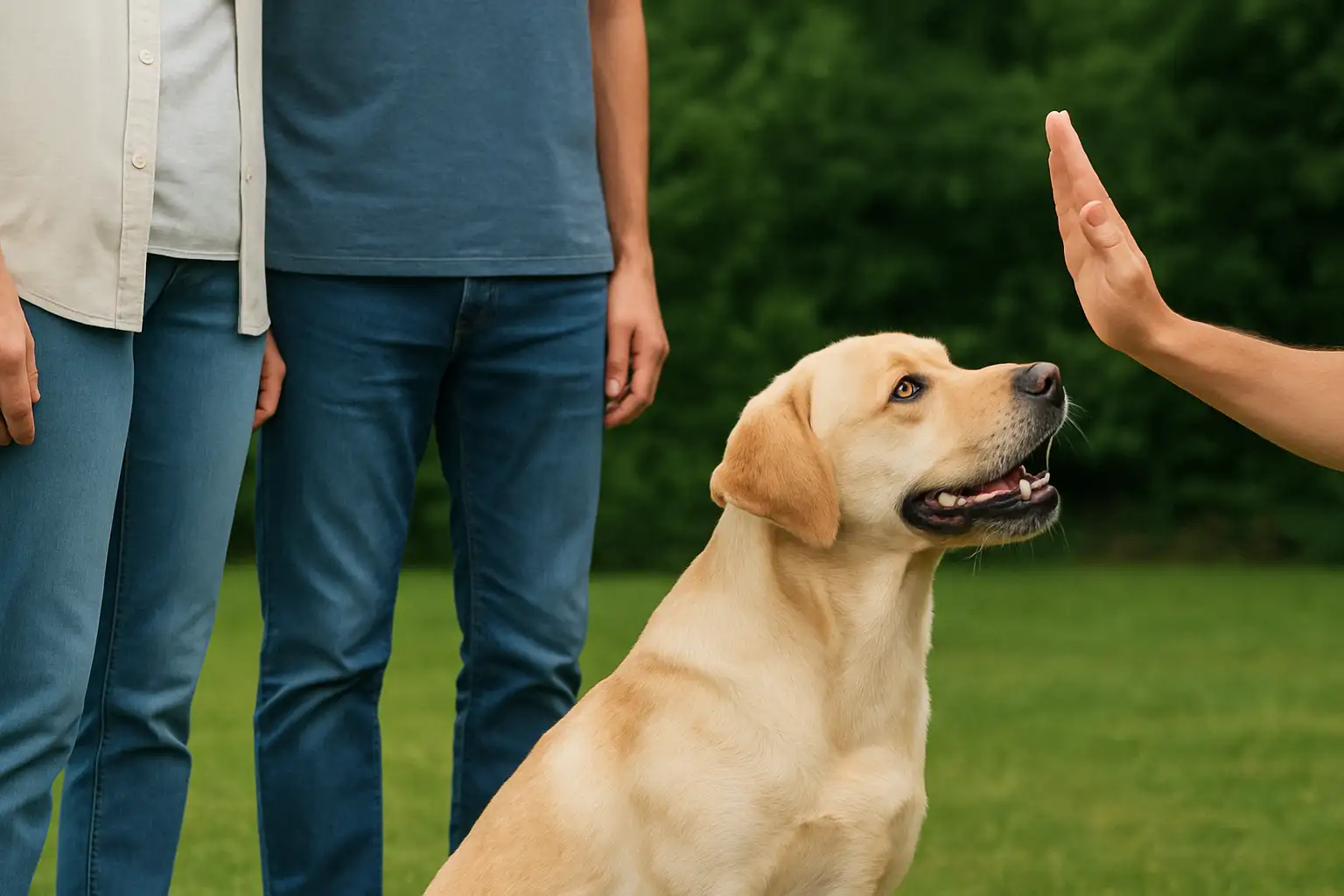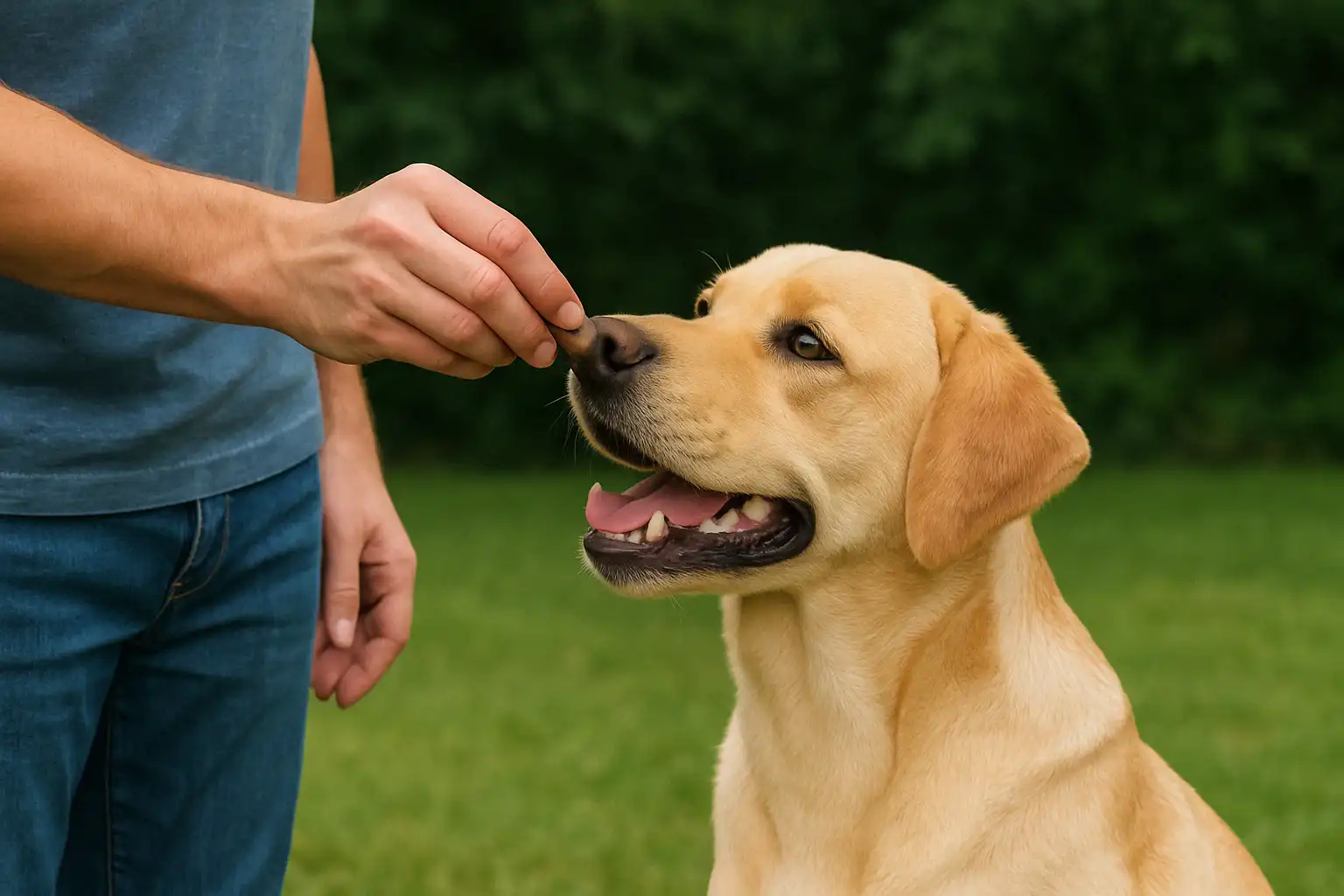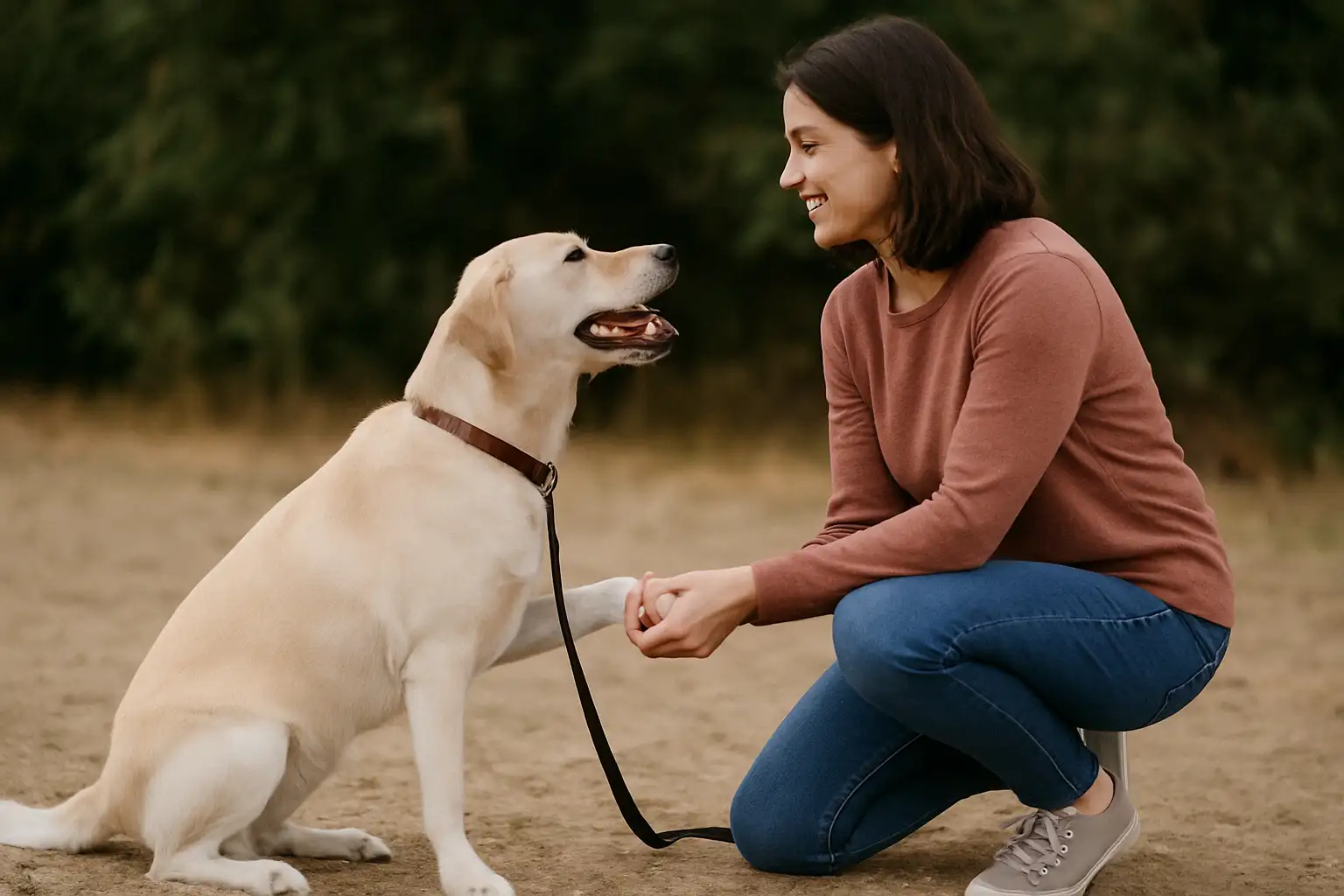Mastering what are the 5 golden rules of dog training—consistency, positive reinforcement, understanding canine behavior, proper socialization, and realistic expectations—will transform your relationship with your pup and make training both effective and enjoyable.
When I brought home my first dog, a rambunctious Lab mix named Cooper, I was completely unprepared for the training challenges ahead. Those first few weeks were a blur of chewed shoes, ignored commands, and more than a few moments where I questioned if we were compatible at all. What turned everything around? Discovering and implementing what are the 5 golden rules of dog training that professional trainers swear by.
If you’re struggling with a new puppy or a stubborn adult dog, you’re not alone. The good news is that successful dog training doesn’t require magical powers or professional certification—just understanding and consistently applying what are the 5 golden rules of dog training: consistency in commands and rules, positive reinforcement instead of punishment, understanding natural canine behavior, proper socialization with various environments, and setting realistic expectations for progress.
These principles have transformed countless chaotic households into peaceful homes where humans and canines live in harmony. Understanding what are the 5 golden rules of dog training can make all the difference between frustration and success.
In this comprehensive guide to what are the 5 golden rules of dog training, I’ll walk you through each principle, explain why it works based on canine psychology, and share real-life examples from my experience training not just my own dogs, but helping friends and family with theirs too. Whether you’re dealing with basic commands, behavioral issues, or just want to strengthen your bond, these rules provide the foundation for success.
The Importance of Consistency in Dog Training
The single most important element when considering what are the 5 golden rules of dog training—and the one most pet parents struggle with—is consistency. When I first started training Cooper, I’d sometimes let him jump on me when I was wearing old clothes but scold him when I was dressed for work. No wonder he was confused! Dogs don’t understand situational exceptions—they understand patterns.
Consistency means everyone in your household follows the same rules, uses the same commands, and enforces the same boundaries—100% of the time. This creates clear communication that your dog can understand and trust.
Dogs thrive on routine and predictability. When training is inconsistent, they experience the canine equivalent of anxiety and confusion. Think about it from your dog’s perspective: if sometimes jumping on the couch leads to pets and praise, but other times it results in being told “off” and removed, what’s the actual rule?
I noticed a dramatic improvement in Cooper’s behavior once our entire family committed to using the same command words and enforcing the same rules. This consistency, one of the essential what are the 5 golden rules of dog training professionals recommend, transformed our results. Within just two weeks, his response time to commands improved by about 80%, and the confused head-tilting when given instructions all but disappeared.
To implement consistency in your dog training:
- Create a list of house rules that everyone agrees to enforce (Can the dog be on furniture? What commands will you use for basic behaviors?)
- Use the exact same command words for specific behaviors (not “down” sometimes and “off” other times)
- Enforce rules every single time, not just when it’s convenient
- Ensure all family members provide the same consequences for both desired and unwanted behaviors
- Maintain a consistent daily schedule for feeding, walks, and training sessions

The power of consistency became crystal clear when my neighbor was struggling with her Border Collie puppy’s leash pulling. During our discussions, I discovered her husband was allowing pulling during morning walks while she was enforcing no-pull rules in the evening. Once they aligned their approach, their puppy’s leash manners improved within days, not months.
Positive Reinforcement Techniques for Effective Training
When discussing what are the 5 golden rules of dog training, positive reinforcement stands out as the second essential principle. Studies have consistently shown that reward-based training produces better results with fewer behavioral side effects than aversive methods.
When I first started training Cooper, I made the mistake of focusing on correcting bad behaviors rather than reinforcing good ones. The breakthrough came when I shifted to celebrating what he did right instead of punishing what he did wrong – a fundamental concept within the 5 golden rules of dog training that transformed our relationship.
Positive reinforcement works because dogs, like humans, repeat behaviors that lead to pleasant outcomes. When your dog sits and receives a treat, they make the connection: “Sitting makes good things happen!” This creates a willing, enthusiastic learner rather than a dog who obeys out of fear.
Research from veterinary behaviorists shows that dogs trained with positive methods display:
- Lower stress hormones during training sessions
- Faster learning of new commands
- Better retention of training over time
- Stronger bonds with their owners
- Fewer behavioral problems like aggression or anxiety
For positive reinforcement to work as a golden rule of dog training, timing and consistency are crucial:
- Reward immediately (within 1-2 seconds of the desired behavior)
- Start with high-value treats for new or difficult behaviors
- Use a marker word (like “yes!” or a clicker) to precisely mark the moment of correct behavior
- Gradually reduce treats as behaviors become reliable, replacing with praise and life rewards
- Never run out of ways to reward—use toys, play, access to spaces, or activities your dog enjoys
I discovered that Cooper was toy-motivated more than food-motivated, which was a game-changer for our training. Once I started using his favorite ball as a reward instead of treats, his recall improved dramatically—even in high-distraction environments like the dog park.

Many people worry that positive reinforcement means having treats forever, but that’s a misconception. As behaviors become more reliable, you can implement a variable reward schedule (not rewarding every single time) which actually strengthens behaviors for the long-term.
My Cooper now responds to commands even when there’s no obvious reward because the behavior itself has become rewarding. We gradually transitioned from treating every successful “come” to treating randomly, then to just enthusiastic praise, and finally to a simple “good boy” that maintains his reliable recall four years later.
Understanding Canine Behavior for Successful Training
The third principle in what are the 5 golden rules of dog training is understanding that dogs are dogs—not humans in fur coats. They have species-specific behaviors, communication methods, and needs that differ significantly from ours. When we train with their natural behavior patterns in mind, we set ourselves up for success.
I made a critical mistake with my first dog by interpreting his actions through a human lens. When he destroyed my shoes while I was gone, I thought he was “getting revenge” for being left alone. In reality, he was displaying classic separation anxiety and needed help, not punishment.
Dogs are constantly communicating with us through their body language, but many owners miss these signals. Understanding what your dog is saying can prevent training setbacks and behavioral issues:
- Whale eye (showing whites of eyes) indicates stress or fear
- A stiff, still body with raised hackles signals arousal or potential aggression
- Yawning, lip-licking, and turning away are calming signals that say “I need space”
- A relaxed, wiggly body with loose movements shows comfort and happiness
Once I learned to recognize Cooper’s stress signals during training (excessive panting, looking away), I could adjust my approach before he became overwhelmed. Applying what are the 5 golden rules of dog training taught me about canine communication improved our training efficiency by at least 50%.
Each dog breed (or mix) has genetic predispositions that influence behavior and trainability. Understanding these can help you tailor your approach:
- Herding breeds like Border Collies may try to control movement through nipping or circling
- Terriers are often highly prey-driven and may struggle with small animal distractions
- Scent hounds follow their noses and benefit from nose work integration in training
- Guardian breeds may be naturally more cautious with strangers
When my friend was struggling to train her Beagle to stop following scents during walks, we incorporated short tracking games into their routine. By giving appropriate outlets for this natural behavior, she could then ask for more focused walking the rest of the time.

Understanding developmental stages helps set realistic training goals:
- Puppies (8-16 weeks): Short attention spans, need frequent potty breaks, learning basic socialization
- Adolescents (6-18 months): Testing boundaries, may “forget” previous training, high energy needs
- Adults (2-6 years): Capable of complex training, consistent behavior with proper reinforcement
- Seniors (7+ years): May need accommodations for physical limitations, but can still learn new behaviors
I made the mistake of expecting too much too soon from Cooper as a puppy, which created frustration for both of us. When I adjusted my expectations to match his developmental stage—a key component of what are the 5 golden rules of dog training—our sessions became more productive and less stressful.
The Role of Socialization in Dog Training
The fourth element in what are the 5 golden rules of dog training is proper socialization—exposing your dog to a wide variety of people, animals, environments, and situations in a positive, controlled manner. While many think of socialization as just “meeting other dogs,” it’s actually much broader and forms the foundation for a well-adjusted adult dog.
I learned this lesson the hard way when Cooper developed fear-based reactivity to men wearing hats because I hadn’t properly exposed him to this common sight during his critical socialization period as a puppy.
Puppies have a prime socialization period between approximately 3-14 weeks of age when they’re most receptive to new experiences. During this time:
- Positive exposures create lasting comfort with various stimuli
- Negative experiences can create long-term fears
- Lack of exposure can lead to default fear responses later
Even if you adopt an older dog, socialization remains important—it just may progress more slowly and with more careful management.
Effective socialization as part of what are the 5 golden rules of dog training means managing experiences to ensure they’re positive:
- Start with low-intensity versions of new stimuli (distant sounds, calm people)
- Use high-value treats to create positive associations
- Watch body language carefully and don’t force interactions
- Progress gradually to more challenging situations
- Prioritize quality over quantity—one good experience is better than five overwhelming ones
When socializing my second dog, a rescue with an unknown background, I created a checklist of 50 different experiences to gradually work through—everything from walking on different surfaces to hearing vacuum cleaners to meeting people of different ages. This methodical approach to what are the 5 golden rules of dog training helped her confidence grow with each positive encounter.

Socialization isn’t just for puppies—it’s a lifelong process. Even adult dogs benefit from:
- Regular exposure to different environments
- Positive interactions with various types of people
- Controlled meetings with other animals
- Gradual introduction to new situations and stimuli
I maintain Cooper’s socialization by taking different walking routes, visiting pet-friendly stores, and arranging playdates with stable dogs. At nine years old, he’s still building positive associations with new experiences, which keeps him adaptable and confident.
Setting Realistic Expectations for Dog Training Success
The fifth golden rule of dog training is perhaps the most overlooked but crucial for long-term success: setting realistic expectations. When exploring what are the 5 golden rules of dog training, this is the one most often missing from quick guides. This applies both to what your dog can achieve and how quickly progress will occur.
When I started training Cooper, I expected him to learn new commands in just a few repetitions like the dogs I saw on TV. This unrealistic expectation led to frustration for both of us until I understood that real training takes time, consistency, and patience.
Every dog is an individual with unique:
- Learning style and speed
- Motivation level and preferred rewards
- Attention span and distractibility
- Physical and cognitive abilities
- Past experiences that shape current behavior
My friend’s Labrador learned “sit” in one five-minute session, while it took my terrier mix two weeks of consistent practice. Neither dog was “better” or “worse”—they simply had different learning patterns that required individualized approaches.
Understanding realistic timelines helps maintain motivation through the training process. When exploring what are the 5 golden rules of dog training, it’s crucial to recognize that different skills require different time investments:
- Basic commands (sit, down, stay): 1-4 weeks for reliability in low-distraction environments
- Solid recall in distracting environments: 6-12 months of consistent practice
- Loose-leash walking: 3-6 months for consistent results
- Resolving behavioral issues (reactivity, aggression): Often 6+ months with professional support
- Complete reliability in all situations: A lifelong commitment to training and reinforcement
When I adjusted my expectations to align with these realistic timelines, our training became much less stressful. Instead of being disappointed by “slow” progress, I could celebrate small improvements along the way.
Even with perfect application of what are the 5 golden rules of dog training, you’ll face challenges:
- Regression during adolescence (6-18 months): Return to basics and maintain consistency
- Training plateaus: Change environments, increase difficulty gradually, or try new rewards
- Behavioral issues: Consult professionals early rather than waiting for problems to escalate
- Distractions: Progress gradually from minimal to moderate to high-distraction environments
I experienced a significant training setback when Cooper hit adolescence around 8 months old. Suddenly, his reliable recall vanished, and he seemed to forget basic commands. By understanding this was a normal developmental phase rather than a training failure—an insight gained from studying what are the 5 golden rules of dog training—I could adjust my approach without frustration.
One aspect of realistic expectations is acknowledging and celebrating incremental improvements:
- Keep a training journal to track progress
- Take videos periodically to see changes that might be subtle day-to-day
- Celebrate “personal best” moments, not just “perfect” performance
- Remember that consistency over time, not perfection in any single session, leads to success
When Cooper finally mastered loose-leash walking after months of work, the satisfaction was incredible—not just because he’d learned the skill, but because we’d persevered together through the process.
The most powerful aspect of what are the 5 golden rules of dog training is how they work together as a system, each reinforcing the others to create lasting results. Let me share how these principles transformed my approach with Cooper:
- Consistency: By establishing clear rules and commands that everyone in our household followed without exception
- Positive Reinforcement: Using rewards and praise to motivate learning instead of punishment to suppress behavior
- Understanding Canine Behavior: Working with Cooper’s natural instincts and communication style rather than against them
- Proper Socialization: Ensuring exposure to a wide range of experiences in a positive, controlled manner
- Realistic Expectations: Accepting that training is a journey of gradual progress, not overnight transformation
The combination of these principles turned our chaotic relationship into a harmonious partnership based on mutual trust and clear communication. These aren’t just training techniques—they’re the foundation of a healthy human-canine relationship.

Once you’ve established these golden rules in your training approach, you can:
- Teach advanced behaviors and tricks
- Participate in dog sports like agility, rally, or nosework
- Address specific behavioral challenges with a solid foundation in place
- Even train specialized skills like therapy dog work or assistance tasks
The possibilities are endless when you’ve established clear communication through these fundamental principles.
While the 5 golden rules of dog training provide a solid foundation for most training needs, some situations warrant professional guidance:
- Aggressive behavior toward people or other animals
- Severe anxiety or fear responses
- Compulsive behaviors that interfere with normal life
- Training that isn’t progressing despite consistent application of these principles
- Specialized training needs for service or working dogs
I worked with a professional trainer to address Cooper’s reactivity toward other dogs, and the investment was invaluable. The trainer didn’t replace these golden rules—she helped me apply them more effectively to our specific challenge.
Conclusion
What are the 5 golden rules of dog training that truly make a difference? They are consistency, positive reinforcement, understanding canine behavior, proper socialization, and realistic expectations—and together they provide a framework for success that works across breeds, ages, and training goals. By applying these principles with patience and dedication, you can build a relationship with your dog based on mutual trust, clear communication, and joy.
Remember that training isn’t just about teaching your dog to behave—it’s about learning to communicate across species in a way that strengthens your bond. The time and effort you invest in training following these golden rules will return tenfold in the form of a well-adjusted, happy companion who fits seamlessly into your life.
Looking back at my journey with Cooper, from those frustrating early days to our current partnership, I can trace every breakthrough to moments when I fully embraced what are the 5 golden rules of dog training that professional trainers have been using for decades. Whether you’re just starting with a new puppy or working through challenges with an adult dog, these golden rules will guide you toward training success.
FAQs About What Are the 5 Golden Rules of Dog Training
What is the most effective method for dog training?
Positive reinforcement is the most effective method within what are the 5 golden rules of dog training. This approach rewards desired behaviors with treats, praise, or play, making your dog more likely to repeat them. Research shows positive methods produce better results and fewer behavioral issues than punishment-based training.
How long does it take to train a dog using the golden rules?
When following what are the 5 golden rules of dog training, basic commands typically take 1-4 weeks in low-distraction environments. Complex behaviors or reliability in high-distraction settings may take 6-12 months of consistent practice. Training is a lifelong process, not a one-time achievement.
Can old dogs learn new tricks with these training rules?
Yes, dogs of any age can learn new behaviors using what are the 5 golden rules of dog training. While puppies learn quickly during critical periods, adult and senior dogs can absolutely master new commands and behaviors. Older dogs often have better focus and self-control than puppies.
What should I do if my dog doesn’t respond to positive reinforcement?
If your dog seems unresponsive to positive reinforcement, reassess what truly motivates them. Some dogs prefer toys or play over treats, while others respond best to praise. Ensure you’re rewarding immediately after the desired behavior and training in a distraction-free environment initially.
How important is consistency across all family members in dog training?
Consistency among all family members is absolutely essential when applying what are the 5 golden rules of dog training. When everyone uses the same commands, rewards, and boundaries, dogs learn quickly. Inconsistency creates confusion and significantly slows progress.

